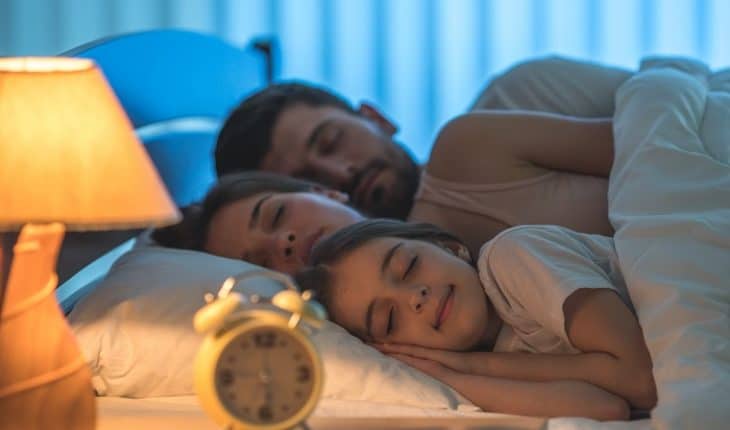Your sleep patterns debunked: A guide for every age: The human anatomy is beyond fascinating. Our ‘body clock’ informs us when it’s time to doze and when to wake up, thus dictating our sleep pattern. Everyone’s sleep schedule is different based on a variety of factors, including age, gender, and lifestyle.
As we age, our sleep pattern changes. While children and older people need more naps through the day, adults can go about their day and sleep through the night due to their busy schedules. To celebrate National Sleep Awareness Month, we talked with Dr Verena Senn from Sleep Science by Emma, who sheds a light on the evolution of sleep as we get older and how to get the best night’s sleep.
The four stages of sleep There are four stages of sleep that repeat throughout our sleep cycle each night and are vital for our physical and cognitive health. Three of those stages fall into a non-REM (non-rapid eye movement) phase, and one in a REM (rapid eye movement) phase.
Stage One: Non-REM sleep
During stage one, you’re in a light-sleep state and can be awoken very easily. Your heartbeat, eye movements, and breathing will slow down and your muscles will begin to relax. You might experience muscles twitching, as well. This stage lasts roughly 10 minutes.
Stage Two: Non-REM sleep
During stage two you’re still in a light-sleep state. Your heartbeat and breathing continue to slow down, while your muscles become more relaxed. Your eye movement and twitching stop but bursts of brain wave activity might occur, which are known as sleep spindles. This stage lasts between 30 and 60 minutes.
Stage Three: Non-REM sleep
During stage three, you’re in a deep-sleep state, and your heart rate and breathing will be at their slowest. This stage is extremely important for your immune health and energy and your muscles will begin to restore. It’s usually difficult to be awoken during this stage, which lasts between 20 and 40 minutes.
Stage Four: REM sleep
The REM stage usually occurs 90 minutes into your sleep cycle and is vital for memory consolidation. During this stage, eye movements and brain waves speed up and your muscles are paralysed. That’s when dreaming occurs. The first REM stage usually lasts about 10 minutes, while each additional REM stage becomes prolonged through the night.
How have sleep patterns changed through the ages?
According to Dr Verena Senn, “sleep and sleep disorders endure significant modifications from birth to old life”. Let’s explore what changes occur in our sleep cycles as we get older and how to make the most of our sleep.
Infant and young children’s sleep pattern
Many parents are anxious about raising their children and sleep forms an important part of a baby’s upbringing. No matter how many books and guides parents read, it can be difficult for them to find peace of mind. But here are all the basics you need to learn about your children’s sleep routine.
As newborns, babies tend to spend the majority of the 24-hour day sleeping. In fact, up to 20 hours are spent sleeping daily, of which about 50% is REM stage sleep, says Dr Verena Senn.
“Frequent awakenings characterise newborn’s sleep, and sleep episodes are generally coupled with a straight transition from alertness into REM.”
As they reach the age of six weeks, their sleep schedules become more consolidated during the night but afternoon naps are still common.
As children grow older, their sleep patterns undergo more changes. By the ages of four and six, the amount of stage four REM sleep reduces further, while stage-three deep sleep increases significantly. Before children go into puberty, it’s common to experience some parasomnias, which are a category of sleep disorders. These include sleepwalking, sleep terrors, and confusional arousals, which are brief arousals or awakenings that occur during stage three. During confusional arousals, a person might open their eyes or talk in their sleep while they remain in bed.
Adolescent and young adults’ sleep patterns
We often blame teenagers for sleeping in and going to bed late, but according to Dr Verena Senn, “there is a propensity for a later sleep onset time during adolescence and difficulties waking up in the morning.” Teenagers are also prone to sleep disorders. Obstructive Sleep Apnoea Syndrome (OSAS), for example, disrupts breathing during sleep. While going to bed early is common, some teenagers might develop a Delayed Sleep Phase Syndrome, which causes difficulties when aligning their sleeping pattern to their day-to-day routine.
“Psychological or mental illnesses, characterised by anxiety and depression, are also frequent in this age range and may induce disrupted sleep,” added Dr Senn.
Young adults can also experience difficulty waking up in the morning, as well as increased frequency of awakenings. Nevertheless, sleep is extremely important during this age period as it supports brain development and helps maintain energy levels. It’s also vital for the mental and physical health of the individual.
Adults and elderlies’ sleep patterns
In middle age, sleep deprivation becomes more common. The total sleep period reduces and individuals experience more frequent awakenings. It’s normal for people to become parents between the ages of 26 and 35, and that can largely affect their sleep quality, especially during the first months of the baby’s life.
“In your 40s, new concerns about sleep can arise including sleep apnoea, decreased quality of sleep, feeling tired throughout the day, changes in hormones, and less production of melatonin,” says Dr Verena Senn.
Elderly people tend to have a short sleep duration during the night but strong inclinations for daytime naps. They primarily experience stage-one or stage-two light sleep and often lack stage-three deep sleep.
Because some older adults might lack growth hormone secretion, they are likely to develop certain sleep disorders. REM Sleep Behaviour Disorder, for example, usually occurs in people over 60 and is “characterised by episodes of vigorous speech or shouting, and violent movement or behaviour”. Medical and psychological illnesses can also occur amongst the elderly, which can cause insomnia.
How much sleep do you need for your age?
Here is how much sleep you need for your age, according to Dr Verena Senn:
| Who | Age | Sleep Duration |
| Newborns | between 0 and 3 months old | 14 to 17 hours per day |
| Infants | between 4 and 11 months old | 12 to 15 hours per day |
| Toddlers | between 1 and 2 years old | 11 to 14 hours per day |
| Preschools | between 3 and 5 years old | 10 to 13 hours per day |
| School-age | between 6 and 13 years old | 9 to 11 hours per day |
| Teens | between 14 and 17 years old | 8-10 hours per day |
| Young Adults | between 18 and 25 years old | 7 to 9 hours per day |
| Adults | between 26 and 64 years old | 7 to 9 hours per day |
| Older Adults | 65 or more years old | 7 to 8 hours per day |
Sleep cycles may vary, so even if your sleep pattern differs from the norm, you can still be getting a good night’s rest and shouldn’t worry.
Sleep and menopause: impact and possible treatments
Menopause, which occurs in late to middle age in women, is associated with a number of symptoms, including hot flushes, sadness, and emotional unpredictability. Sleep is also significantly affected during menopause, and up to 50% of women report problems that affect their sleep routines and daily lives.
During menopause, sleep becomes more fragmented and awakenings are common. This is largely due to declining estrogen levels, physical symptoms such as hot flushes and night sweats, and decreased production of melatonin in the body. Menopause, as well as menses, are related to a disease called Menstrual-Associated Sleep Disorder, which appears in two main forms: insomnia or hypersomnia related to the menstrual cycle, and insomnia associated with menopause. Menopause-related insomnia causes difficulty in maintaining sleep or waking up too early and being unable to go back to sleep.
Luckily, there are a number of solutions that can help you overcome the unpleasant sleep-related symptoms that occur during menopause.
For example, melatonin tablets can help you replenish the diminishing quantities of melatonin in your body and improve your sleep. Dr Verena Senn also recommends Cognitive Behavioural Treatment (CBT) as a menstrual-associated sleep disorder treatment. Other treatments include relaxation techniques, mediations, and mindfulness, which can help reduce stress and anxiety during menopause, so you can sleep better.
You can also make some small changes to your sleep hygiene that can have a great deal of impact on your sleep quality. Louise Rusk of Cowberry Home, a luxurious linen bedding and sleep essentials retailer, commented:
“During menopause, your body temperature tends to fluctuate, which can cause night sweats. To ensure you have uninterrupted sleep, opt for breathable and absorbent materials for your bedding. Linen fabric, for example, has high air permeability and heat conductivity properties, meaning it can support a regular body temperature throughout the seasons. Moreover, its light massing effect will help you relax and facilitate that home retreat experience. The same applies to your mattress material.”
Regardless of our age and sleep patterns, it’s important to ensure that we get a good night’s sleep. This will equip us with the energy to tackle the day and promote our physical and mental health. Experiencing all four stages of sleep is vital for us and we get to enjoy the most fun one of all – the REM stage, which is when we dream of imagined worlds.
Research by Cowberry Home
Sources
https://www.nhsggc.org.uk/kids/life-skills/sleep/ https://www.sleep-science.co.uk/ https://www.sleepadvisor.org/sleep/stage/ https://www.sleepfoundation.org/parasomnias/confusional-arousalhttps://www.northdevonhealth.nhs.uk/wp-content/uploads/2013/01/obstructive_sleep_apnoea_syndrome.pdf https://thesleepcharity.org.uk/information-support/adults/sleep-disorders/delayed-sleep-phase/ https://www.diabetes.co.uk/sleep/how-you-needs-for-sleep-changes.html https://londonsleepcentre.com/sleep-disorders/rem-sleep-behaviour-disorder/ https://www.sleepstation.org.uk/articles/health/menopause-and-sleep/ https://londonsleepcentre.com/sleep-disorders/menstrual-associated-sleep-disorder/
- Gut microbiome could delay onset of type 1 diabetes - 3rd April 2025
- The da Vinci 5 Robot Is Set To Transform Bariatric Care: - 31st March 2025
- Beyond money: the hidden drivers fuelling child food insecurity - 31st March 2025






